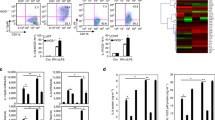Abstract
The innate immune system functions as a defensive front line against pathogenic invasion, but the proinflammatory products of activated monocytes and macrophages (e.g., TNF and NO) can also injure normal cells. Anti-inflammatory mediators restrain the innate immune response and prevent excessive collateral tissue damage. Spermine, a ubiquitous biogenic polyamine, specifically and reversibly suppresses the synthesis of monocyte proinflammatory cytokines. This may provide a counterregulatory mechanism to restrain monocyte activation in injured or infected tissues and in tumors where spermine levels are significantly increased. Here we show that monocyte spermine uptake was significantly increased following lipopolysaccharide stimulation. The polyamine analogue l,4-bis(3-aminopropyl)-piperazine (BAP) inhibited LPS-stimulated monocyte spermine uptake via the “nonselective” polyamine transporter. BAP fully restored macrophage TNF synthesis despite the presence of spermine, indicating that the mechanism of monocyte deactivation by spermine is dependent on spermine uptake. Administration of BAP in vivo significantly augmented the development of carrageenan-induced paw edema and nitric oxide release. Thus, endogenous spermine normally inhibits the innate inflammatory response by restraining macrophages.





Similar content being viewed by others
References
Nathan C. (1995) Natural resistance and nitric oxide. Cell 82: 873–876.
Zhang M, Tracey KJ. (1998) Tumor necrosis factor. In: Thomson AW (ed). The Cytokine Handbook, 3rd ed. Academic Press, London, pp. 517–548.
Dinarello CA. (1998) Interleukin-1, interleukin-1 receptors and interleukin-1 receptor antagonist. Int. Rev. Immunol. 16: 457–499.
Pfeffer K, Matsuyama T, Kundig TM, et al. (1993) Mice deficient for the 55 kD tumor necrosis factor receptor are resistant to endotoxic shock, yet succumb to I. monocytogenes infection. Cell 73: 457–467.
Fenton MJ, Golenbock DT. (1998) LPS-binding proteins and receptors. J. Leukoc. Biol. 64: 25–32.
Glauser MP. (1996) The inflammatory cytokines. New developments in the pathophysiology and treatment of septic shock. Drugs 52 Suppl 2: 9–17.
Tracey KJ, Fong Y, Hesse DG. (1986) Shock and tissue injury induced by recombinant human cachectin. Science 234: 470–474.
Tsunawaki S, Sporn M, Ding A, Nathan C. (1988) Deactivation of macrophages by transforming growth factor-beta. Nature 334: 260–262.
Kulkarni AB, Huh CG, Becker D, et al. (1993) Transforming growth factor beta 1 null mutation in mice causes excessive inflammatory response and early death. Proc. Natl. Acad. Sci. U.S.A. 90: 770–774.
Howard M, Muchamuel T, Andrade S, Menon S. (1993) Interleukin 10 protects mice from lethal endotoxemia. J. Exp. Med. 177: 1205–1208.
Gerard C, Bruyns C, Marchant A, et al. (1993) Interleukin 10 reduces the release of tumor necrosis factor and prevents lethality in experimental endotoxemia. J. Exp. Med. 177: 547–550.
Sternberg EM, Chrousos GP, Wilder RL, Gold PW. (1992) The stress response and the regulation of inflammatory disease. Ann. Intern. Med. 117: 854–866.
Russo-Marie F. (1992) Macrophages and the glucocorticoids. J. Neuroimmunol. 40: 281–286.
Wickstrom K. (1991) Polyamines in rabbit aqueous humor after surgical trauma to the eye. Curr. Eye. Res. 10: 463–469.
Cipolla B, Guille F, Moulinoux JP, et al. (1993) Polyamines and prostatic carcinoma: Clinical and therapeutic implications. Eur. Urol. 24: 124–131.
Hirsch JG, Dubos RJ. (1952) The effect of spermine on tubercle bacilli. J. Exp. Med. 95: 191–208.
Zhang M, Caragine T, Wang H, et al. (1997) Spermine inhibits proinflammatory cytokine synthesis in human mononuclear cells: A counter-regulatory mechanism that restrains the immune response. J. Exp. Med. 185: 1759–1768.
Bowlin TL, Hoeper BJ, Rosenberger AL, Davis GF, Sunkara PS. (1990) Effects of three irreversible inhibitors of ornithine decarboxylase on macrophage-mediated tumoricidal activity and antitumor activity in bl6fl tumor-bearing mice. Cancer Res. 50: 4510–4514.
Byers TL, Pegg AE. (1989) Properties and physiological function of the polyamine transport system. Am. J. Physiol. 257: C545–C553.
Seiler N, Delcros JG, Moulinoux JP. (1996) Polyamine transport in mammalian cells. An update. Int. J. Biochem. Cell. Biol. 28: 843–861.
Haven CA, Olson JW, Arcot SS, Gillespie MN. (1992) Polyamine transport and ornithine decarboxylase activity in hypoxic pulmonary artery smooth muscle cells. Am. J. Respir. Cell Mol. Biol. 7: 286–292.
Colombatto S, De Agostini M, Corsi D, Sinicco A. (1989) Polyamines in lymphocytes from patients infected by human immunodeficiency virus. Biol. Chem. Hoppe Seyler 370: 745–748.
Clarke JR, Tyms AS. (1991) Polyamine biosynthesis in cells infected with different clinical isolates of human cytomegalovirus. J. Med. Virol. 34: 212–216.
Gaugas JM. (1980) Polyamines in biomedical research. In: Gaugas JM (ed). Polyamines in Biomedical Research. John Wiley & Sons, Chichester.
Paschen W, Cleef M, Rohn G, Muller M, Pajunen AE. (1993) Ischemia-induced disturbances of polyamine synthesis. Prog. Brain Res. 96: 147–160.
Colella G, Cianciulli S, De Santis A, et al. (1994) The determination of polyamines in tumors of the maxillofacial area (in Italian). Minerva Stomatol. 43: 133–136.
Wei XQ, Charles IG, Smith A, et al. (1995) Altered immune responses in mice lacking inducible nitric oxide synthase. Nature 375: 408–411.
Salvemini D, Wang ZQ, Wyatt PS, et al. (1996) Nitric oxide: A key mediator in the early and late phase of carrageenan-induced rat paw inflammation. Br. J. Pharmacol. 118: 829–838.
Cunha FQ, Poole S, Lorenzetti BB, Ferreira SH. (1992) The pivotal role of tumour necrosis factor alpha in the development of inflammatory hyperalgesia. Br. J. Pharmacol. 107: 660–664.
Kanof ME, Rance NE, Hamilton SR, Luk GD, Lake AM. (1987) Congenital diarrhea with intestinal inflammation and epithelial immaturity. J. Pediatr. Gastroenterol. Nutr. 6: 141–146.
Faist E, Schinkel C, Zimmer S. (1996) Update on the mechanisms of immune suppression of injury and immune modulation. World J. Surg. 20: 454–459.
Elgert KD, Alleva DG, Mullins DW. (1998) Tumor-induced immune dysfunction: The macrophage connection. J. Leukoc. Biol. 64: 275–290.
Taylor KA. (1998) Immune responses of cattle to african trypanosomes: Protective or pathogenic? Int. J. Parasitol. 28: 219–240.
Wang H, Zhang M, Soda K, Sama A, Tracey KJ. (1997) Fetuin protects the fetus from TNF [letter]. Lancet 350: 861–862.
Fujiwara K, Bai G, Kitagawa T, Tsuru D. (1998) Immunoelectron microscopic study for polyamines. J. Histochem. Cytochem. 46: 1321–1328.
Author information
Authors and Affiliations
Corresponding author
Rights and permissions
About this article
Cite this article
Zhang, M., Borovikova, L.V., Wang, H. et al. Spermine Inhibition of Monocyte Activation and Inflammation. Mol Med 5, 595–605 (1999). https://doi.org/10.1007/BF03402072
Accepted:
Published:
Issue Date:
DOI: https://doi.org/10.1007/BF03402072




